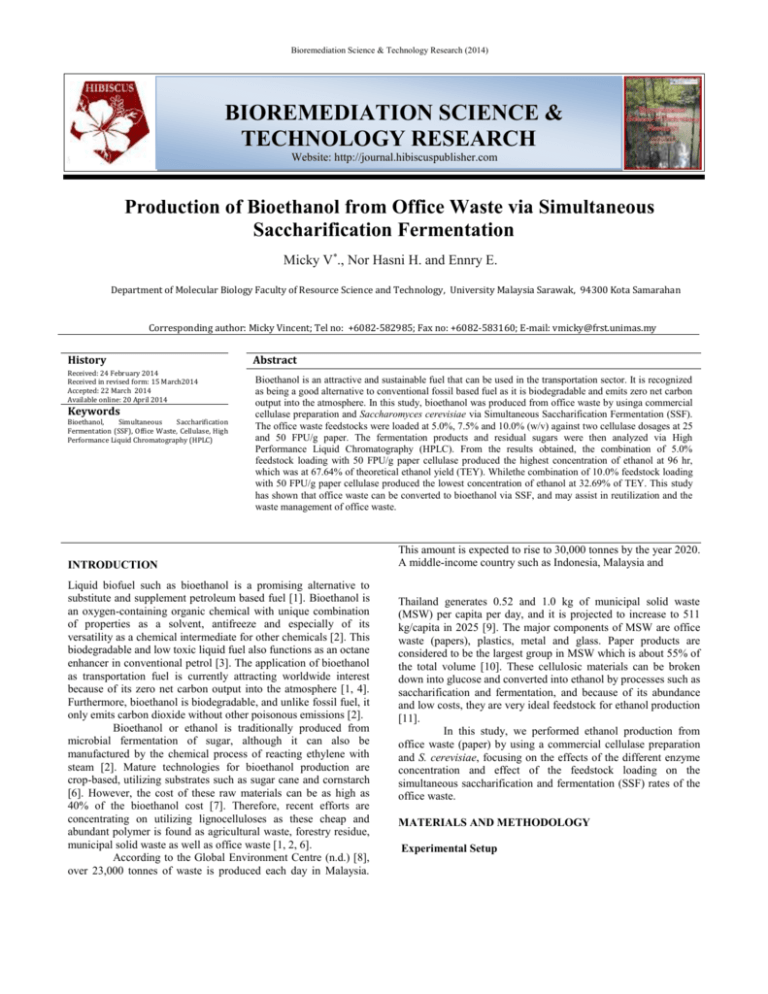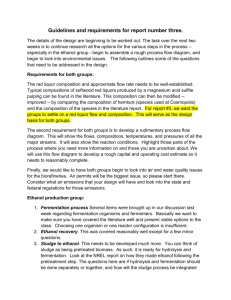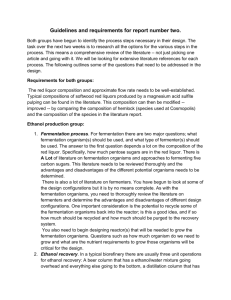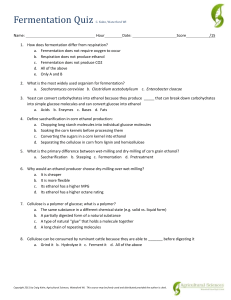bioremediation science & technology research
advertisement

Bioremediation Science & Technology Research (2014) BIOREMEDIATION SCIENCE & TECHNOLOGY RESEARCH Website: http://journal.hibiscuspublisher.com Production of Bioethanol from Office Waste via Simultaneous Saccharification Fermentation Micky V*., Nor Hasni H. and Ennry E. Department of Molecular Biology Faculty of Resource Science and Technology, University Malaysia Sarawak, 94300 Kota Samarahan Corresponding author: Micky Vincent; Tel no: +6082-582985; Fax no: +6082-583160; E-mail: vmicky@frst.unimas.my History Received: 24 February 2014 Received in revised form: 15 March2014 Accepted: 22 March 2014 Available online: 20 April 2014 Keywords Bioethanol, Simultaneous Saccharification Fermentation (SSF), Office Waste, Cellulase, High Performance Liquid Chromatography (HPLC) Abstract Bioethanol is an attractive and sustainable fuel that can be used in the transportation sector. It is recognized as being a good alternative to conventional fossil based fuel as it is biodegradable and emits zero net carbon output into the atmosphere. In this study, bioethanol was produced from office waste by usinga commercial cellulase preparation and Saccharomyces cerevisiae via Simultaneous Saccharification Fermentation (SSF). The office waste feedstocks were loaded at 5.0%, 7.5% and 10.0% (w/v) against two cellulase dosages at 25 and 50 FPU/g paper. The fermentation products and residual sugars were then analyzed via High Performance Liquid Chromatography (HPLC). From the results obtained, the combination of 5.0% feedstock loading with 50 FPU/g paper cellulase produced the highest concentration of ethanol at 96 hr, which was at 67.64% of theoretical ethanol yield (TEY). Whilethe combination of 10.0% feedstock loading with 50 FPU/g paper cellulase produced the lowest concentration of ethanol at 32.69% of TEY. This study has shown that office waste can be converted to bioethanol via SSF, and may assist in reutilization and the waste management of office waste. INTRODUCTION Liquid biofuel such as bioethanol is a promising alternative to substitute and supplement petroleum based fuel [1]. Bioethanol is an oxygen-containing organic chemical with unique combination of properties as a solvent, antifreeze and especially of its versatility as a chemical intermediate for other chemicals [2]. This biodegradable and low toxic liquid fuel also functions as an octane enhancer in conventional petrol [3]. The application of bioethanol as transportation fuel is currently attracting worldwide interest because of its zero net carbon output into the atmosphere [1, 4]. Furthermore, bioethanol is biodegradable, and unlike fossil fuel, it only emits carbon dioxide without other poisonous emissions [2]. Bioethanol or ethanol is traditionally produced from microbial fermentation of sugar, although it can also be manufactured by the chemical process of reacting ethylene with steam [2]. Mature technologies for bioethanol production are crop-based, utilizing substrates such as sugar cane and cornstarch [6]. However, the cost of these raw materials can be as high as 40% of the bioethanol cost [7]. Therefore, recent efforts are concentrating on utilizing lignocelluloses as these cheap and abundant polymer is found as agricultural waste, forestry residue, municipal solid waste as well as office waste [1, 2, 6]. According to the Global Environment Centre (n.d.) [8], over 23,000 tonnes of waste is produced each day in Malaysia. This amount is expected to rise to 30,000 tonnes by the year 2020. A middle-income country such as Indonesia, Malaysia and Thailand generates 0.52 and 1.0 kg of municipal solid waste (MSW) per capita per day, and it is projected to increase to 511 kg/capita in 2025 [9]. The major components of MSW are office waste (papers), plastics, metal and glass. Paper products are considered to be the largest group in MSW which is about 55% of the total volume [10]. These cellulosic materials can be broken down into glucose and converted into ethanol by processes such as saccharification and fermentation, and because of its abundance and low costs, they are very ideal feedstock for ethanol production [11]. In this study, we performed ethanol production from office waste (paper) by using a commercial cellulase preparation and S. cerevisiae, focusing on the effects of the different enzyme concentration and effect of the feedstock loading on the simultaneous saccharification and fermentation (SSF) rates of the office waste. MATERIALS AND METHODOLOGY Experimental Setup Bioremediation Science & Technology Research (2014) A flow-chart of the overall experimental setup is shown in Figure 1. All experiments were conducted in duplicate (n=2) and analyses were done in triplicate (n = 3). Ethanol, glucose and cellobiose were analyzed using a High Performance Liquid Chromatography (Shimadzu/LC-20A, Tokyo, Japan) system that was equipped with a refractive index detector (RID-10A, Tokyo, Japan), Column Oven (CTO-20A, Tokyo, Japan), Communication Bus Module (CBM-20A, Tokyo, Japan) and computer controller. The separation and analysis of ethanol and sugar residues were done on a Bio-Rad Aminex HPX-87H column (150 x 7.8 mm; Bio-Rad Chemical Division, CA, USA) using 0.005 M H2SO4 as the mobile phase at a rate flow of 0.8 ml/min, a 20 μl injection volume and a column temperature of 65 °C [6, 11]. RESULTS AND DISCUSSION Figure 1. Flow-chart of process outlining the steps for simultaneous saccharification and fermentation (SSF) of office waste using cellulase and S. cerevisiae. Cellulase Activities Determination-Filter Paper Unit (FPU) The cellulase activity assay was performed according to the International Union of Pure Applied Chemistry (IUPAC) [12]. Saccharomyces cerevisiae culture preparation Saccharomyces cerevisiae (ATCC 24859) used in this study was obtained from the American TypeCulture Collection (Rockville, MD, USA). The S. cerevisiaeculture inoculum was prepared insterile 100 ml Yeast Malt (YM) Broth overnight at 32 oC with constant agitation (150 rpm), and harvestedvia centrifugation in 50 ml conical centrifuge tubes. The cell concentration densitywas adjusted by using sterile YM Broth to 107–108cells/ml [1]. Simultaneous Saccharification and Fermentation (SSF) Simultaneous saccharification and fermentation (SSF) experiments were carried out in 250 ml flasks with batch cultures of 150 ml final volume, consisting of 1.5 g yeast extract and 3.0 g peptone dissolved in 0.05 M citrate buffer. Office waste (paper) which was the substrate for SSF was added at 5.0%, 7.5% and 10.0% (w/v) before autoclaving. After autoclaving, the enzyme cellulase (Accellerase® 1000, Genencor, CA, USA) was added at 25 FPU/g paperand 50 FPU/g paper and the bottles were aseptically inoculated with the harvested S. cerevisiaeculture. These batch cultures were incubated at 37 oC and agitated at 150 rpm for 5 days. The SSF experiments were performed in duplicate (n=2). Sample Collection Sample aliquots of 1.5 ml were taken at 0 hr, 6 hr, 12 hr, 24 hr, 48 hr, 72 hr, 96 hr and 120 hr. The samples were centrifuged and filtered through a 0.45 μm nylon syringe filter. High-Performance Liquid Chromatography (HPLC) In this study, we performed simultaneous saccharification and fermentation (SSF) on office waste usinga commercial cellulase preparation and S. cerevisiae. SSF is a process that utilizes the enzymatic saccharification of cellulose by cellulolytic enzymes and fermentation of resulting sugars to ethanol by a fermentation microorganism that occurs at the same time, in the same vessel [6]. This process has been studied for several decades and has great potential for the economic production of bioethanol [13]. According to Vincent (2010) [2], SSF is the chosen method to produce ethanol from lignocellulosic biomass as this process alleviates end-product inhibition of the enzymes, and it is also less capital intensive than other procedure such as separate hydrolysis and fermentation (SHF). In addition, the presence of ethanol in the culture medium reduces the potential for microbial contamination [14]. Vincent et al. (2010) [2] further noted that SSF is superior to SHF in terms of overall ethanol yield. Although the current market price of cellulases makes the process less favourable compared to technologies using acid catalysts, working with enzymes are significantly milder, making it possible to combine the cellulose hydrolysis with the ethanol fermentation [2, 15]. To perform fermentation of the sugars released during saccharification, S. cerevisiae was chosen as the fermenting organism because this yeast effectively converts sugar to ethanol due to its rapid rate of glycolysis [11]. Office waste was used as the substrate in our study to produce ethanol because of its abundance and low cost. The most common office waste is paper, consisting mainly of cellulose. These cellulosic materials therefore can be broken down into glucose and finally converted into ethanol via anaerobic fermentation [11]. Saccharification of the office waste was performed using Accellerase® 1000, a commercial cellulase enzyme, to hydrolyze the office waste into fermentable monomeric glucose units. The progression of this hydrolysiscan be seen in Figure 2. On day 0, at 0 hr up to 12 hr (Figure 2A and Figure2B), the shredded paper can be seen to be still intact. As SSF enters the 48 hr period, the shredded paper appeared less distinguishable (Figure 2C) and at 120 hr (Figure 2D), all the paper substrate was hydrolyzed into thick slurries. Initial evaluation on the efficiency of the cellulolytic enzyme in hydrolyzing the office waste can be gauged and validated via the presence of saccharification products such as oligosaccharides, disaccharides and monosaccharides using HPLC. Figure 3 shows the time course of glucose at 25 and 50 FPU/g paper cellulase dosings. Based on graph, for the samples with 25 FPU/g paper cellulase dose, the glucose concentration was higher at 10% of substrate loading compared to 5.0% and 7.5%. The glucose levels were detectable from 6 hr and increased steadily until 12 hr, decreasing thereafter for allsubstrate loads. Bioremediation Science & Technology Research (2014) The same profiles were observed or the fermentation broth dosed with 50 FPU/g paper cellulase. Glucose was producedimmediately after 0 hr and extensively increased until 12 hr and decreasing after 12 hr for 5.0%, 7.5% and 10.0% of paper. However, the Figure 2. Simultaneous saccharification and fermentation (SSF) of office waste at (A) 0 hr, (B) 12 hr, (C) 48 hr and (D) 120 hr. broth containing 10.0% office waste had significantly higher cellobiose concentration at the end of the SSF period, suggesting incomplete hydrolysis of cellobiose into glucose. One possible explanation is that due to high substrate content, conversion efficiencies were compromised due to the increasing viscosity which required higher energy for mixing, and shear in activation of enzymes as well as poor heat transfer [16]. Figure 5 shows the time course of ethanol production for the office waste at three different feedstock loadings against 25 FPU/g paper cellulose and Figure 6 shows the time course of ethanol production for then office waste of three different feedstock loadings against 50 FPU/g paper cellulase. Both graphs show sigmoidal curves, typical of lignocellulosic ethanol production profiles [1, 6, 11]. Except for the 5.0% office waste dosed with 25 FPU/g paper cellulase, ethanol was only produced after 12 hr for all samples. After 12 hr, all the fermentation broths with the three different substrate loading continued to produce ethanol until 120 hr. However, for the 5.0% office waste dosed with 25 FPU/g paper cellulase, ethanol production started to decrease at 96 hr, after peaking at 52.95% TEY (Theoretical Ethanol Yield). For the fermentation broths dosed with 50 FPU/g paper cellulase, production of ethanol started at 12 hr, and increasing steadily until 72 hr (10.0% substrate) and 96 hr (5.0% and 7.5% substrate). However, the ethanol yield slowly decreases from 67.64% to 58.41% TEY after 96 hr until for the 5.0% substrate load until the end of the SSF period. At 7.5% of substrate load, ethanol production also plateaued after the 96 hr. glucose concentration slowly increased from 24 to 48 hr and declining until 120 hr. In general glucose concentration remained low for all samples (< 4 g/l) after 24 hr. Figure 4. Time course of cellobiose production. Figure 3. Time course of glucose production. Cellobiose is another product of SSF from cellulosic materials [2]. The time course of cellobiose production is shown in Figure 4. For the office waste dosed with 25 FPU/g paper cellulase, the amount of cellobiose peaked at approximately 6 g/l for all substrate loadings. After 12 hr, the cellobiose level decreased at different rates until 120 hr. For the office waste dosed with 50 FPU/g paper cellulase, the cellobiose production profiles were also similar. One interesting observation was that all the Bioremediation Science & Technology Research (2014) CONCLUSION This study has shown that office waste can be converted to bioethanol using S. cerevisiae via SSF. From the results obtained, office waste loading at 5.0% w/v coupled with 50 FPU/g paper cellulase was found to produce the highest theoretical ethanol yield at 67.64%. One recommendation is to perform a similar study by conducting fed-batch protocol to attempt higher theoretical ethanol yield. ACKNOWLEDGEMENT This study was supported by the Tun Openg Sago Chair ORC/12/2011(08) and the Malaysian Ministry of Higher Education (MOHE) Fundamental Research Grant Scheme grant FRGS/SG(05)/969/2013(10). Figure 5. Time course of ethanol production at 25 FPU/g paper cellulase. Based on Table 1, results indicate that 5.0% of paper loading for both 25 FPU/g paper and 50 FPU/g paper enzyme doses produced the highest ethanol yield compared to 7.5% and 10.0% of paper loading. Adding more enzyme at 50 FPU/g paper also significantly produce more ethanol which was at 67.64% TEY, compared to 52.95% TEY of ethanol for 25 FPU/g paper celullase dose. According to Baiet al., (2007) [17], sugar concentrations also affect the production of ethanol. Therefore, the complete hydrolysis of office waste into glucose by the cellulase can affect the rate production of ethanol. Therefore, in general, less ethanol was produced in the fermentation broth with 10.0% substrate as significant amount of cellobiose was still detected until 120 hr, as shown in Figure 4, suggesting partial hydrolysis. Figure 6. Time course of ethanol production at 50 FPU/g paper cellulase. Table 1. Highest theoretical ethanol yield (TEY) data. Enzyme Dosage 25 FPU/g paper 50 FPU/g paper Paper Loading (%) 5 7.5 10 5 7.5 10 Highest TEY (%) 52.95 43.50 42.79 67.64 40.03 32.69 REFERENCES [1] Vincent M, Anthony LP, van Leeuwen J (Hans). Ethanol production via simultaneous saccharification and fermentation of sodium hydroxide treated corn stover using Phanerochaete chrysosporium and Gloeophyllum trabeum. Bioresour Technol. 2014; 158:1–6. [2] Vincent M. Sequential saccharification and fermentation of corn stover for the production of fuel ethanol using wood-rot fungi, Saccharomyces cerevisiae and Escherichia coli K011. Ph.D. Thesis. Iowa State University: US; 2010. [3] Altintas M, Ulgen KO, Kirdar B, Onsan ZI, Oliver SG. Improvement of ethanol production from starch by recombinant yeast through manipulation of environmental factors. Enzyme Microb Technol. 2002; 31:640–647. [4] Yamashita Y, Sasaki C, Nakamura Y. Development of efficient system for ethanol production from paper sludge pretreated by ball milling and phosphoric acid. Carbohydrate Polymer. 2010; 79:250–254. [5] Rodríguez-Antón LM, Hernández-Campos M, Sanz-Pérez F. Experimental determination of some physical properties of gasoline, ethanol and ETBE blends. Fuel. 2013; 112:178–184. [6] Vincent M, Anthony L, van Leeuwen J. (Hans). Simultaneous saccharification and fermentation of ground corn stover for the production of ethanol using Phanerocheate chrysosporium, Gloeophyllum trabeum, Saccharomyces cerevisiae, and Escherichia coli K011. J Microbiol Biotechnol. 2011; 21(7):703– 710. [7] Wyman CE. Opportunities and technological challenges of bioethanol. Washington DC: National Research Council; 1999.p. 1–48. [8] Global Environment Centre. Retrieved on April 15, 2014 from http://www.gecnet.info/index.cfm?&menuid=83. [9] Ismail SNS, Manaf LA. The challenge of future landfill: A case study ofMalaysia. J Toxicol EnvironHealth Sci. 2013; 5(6):86–96. [10] Muttamara S, Visanathan C, Alwis KU. Solid waste recycling and reuse in Bangkok. Waste Manag Res. 1994; 12:151–163. [11] Vincent M, Anthony L, van Leeuwen J. (Hans). Evaluation of potential fungal species for the in situ simultaneous saccharification and fermentation (SSF) of cellulosic materials. Malaysian J Microbiol. 2011; 7(3):120–138. [12] Ghose TK. Measurement of cellulase activities. Pure Appl Chem. 1987; 59:257–268. Bioremediation Science & Technology Research (2014) [13] Takagi M, Abe S, Suzuki S, Emert GH, Yata N. A method for production of alcohol directly from cellulose using cellulase and yeast. ProcBioconversion Symp. Delhi; 1977. p. 551. [14] Wu Z, Lee YY. Nonisothermal simultaneous saccharification and fermentation for direct conversion of lignocellulosic biomass to ethanol. Appl Biochem Biotechnol. 1998; 70–72:479–491. [15] Kádár Z, Szengyel Z, Réczey K. Simultaneous saccharification and fermentation (SSF) of industrial wastes for the production of ethanol. Ind Crops Prod. 2004; 20:103-110. [16] Gupta R, Sanjay K, James G, Kubad RC. Kinetic study of batch and fed-batch enzymatic saccharification of pretreated substrate and subsequent fermentation to ethanol. Biotechnol Biofuels. 2012; 5:1-10. [17] Bai FW, Anderson WA, Moo-Young M. Ethanol fermentation technologies from sugar and starch feedstocks. Biotechnol Adv. 2007; 26:89-105.






